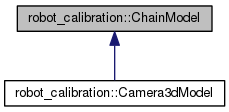Model of a kinematic chain. This is the basic instance where we transform the world observations into the proper root frame. More...
#include <chain.h>

Public Member Functions | |
| ChainModel (const std::string &name, KDL::Tree model, std::string root, std::string tip) | |
| Create a new chain model. | |
| KDL::Frame | getChainFK (const CalibrationOffsetParser &offsets, const sensor_msgs::JointState &state) |
| Compute the forward kinematics of the chain, based on the offsets and the joint positions of the state message. | |
| std::string | name () const |
| virtual std::vector < geometry_msgs::PointStamped > | project (const robot_calibration_msgs::CalibrationData &data, const CalibrationOffsetParser &offsets) |
| Compute the position of the estimated points. | |
| virtual | ~ChainModel () |
Protected Attributes | |
| std::string | name_ |
| std::string | root_ |
| std::string | tip_ |
Private Attributes | |
| KDL::Chain | chain_ |
Detailed Description
Model of a kinematic chain. This is the basic instance where we transform the world observations into the proper root frame.
Each world observation is an estimated point in some frame. In the case of the four led gripper, each led has an absolutely known location in the gripper_led_frame. The ordering of the points is:
_ _
| | | |
| | | |
| | | |
| | | |
| | | |
| | gripper | |
|---------------------|
| |
| 0 3 |
| |
| X <------------ gripper_led_frame
| |
| 2 1 |
| |
/When using a checkerboard, each interesection on the checkerboard is an observation point. Even though checkerboard *should* be flat, the code assumes that each checkerboard intersection has 3 degrees of translational freedom. The gripper_led_frame to checkerboard_frame transformation becomes a set of free parameters in the calibration.
Based on the 6x5 checkboard, the ordering of the oberservation points produced by the OpenCV chessboard finder is always the same:
____________________________
| |
| ### ### ### ### |
| ### ### ### ### |
| ### ### ### LL## | 11 First Observation Point
| ### ### ##LL ### | 11
| ### ### ### ### |
| ### ### ### ### | 22 Second Observation Point
| ### ### ### ### | 22
| ### ### ### ### |
| ##22 ### ### ### | LL Last (20th) Obervation Point
| 22## ### ### ### | LL
| ### ### ### ### |
| 11## ### ### ### |
| ##11 ### ### ### |
| ### ### ### ### | gripper_link
| ### ### ### ### | X-axis (increasing row)
| | ^
| _____ | | gripper_link
| | | | | ----> Z-axis (increasing col)
| | |
| | 0<----- gripper_link frame origin
|__________| |___________
| |
___|_____|___
| |
| Gripper |
| |
For the ideal checkboard:
- All the checkerboard points should fall on or near Y=0 plane.
- The intersection points are spread appart by 25mm
- The X-offset from the gripper frame to the first observation point is 100mm
- The Z-offset from the gripper frame to the first observation point is -50mm The checkboard points are numberered so that the lowest Z value are the first points
Constructor & Destructor Documentation
| robot_calibration::ChainModel::ChainModel | ( | const std::string & | name, |
| KDL::Tree | model, | ||
| std::string | root, | ||
| std::string | tip | ||
| ) |
Create a new chain model.
- Parameters:
-
model The KDL model of the robot's kinematics. root The name of the root link, must be consistent across all models used for error modeling. Usually 'base_link'. tip The tip of the chain.
Definition at line 40 of file models.cpp.
| virtual robot_calibration::ChainModel::~ChainModel | ( | ) | [inline, virtual] |
Member Function Documentation
| KDL::Frame robot_calibration::ChainModel::getChainFK | ( | const CalibrationOffsetParser & | offsets, |
| const sensor_msgs::JointState & | state | ||
| ) |
Compute the forward kinematics of the chain, based on the offsets and the joint positions of the state message.
Definition at line 104 of file models.cpp.
| std::string robot_calibration::ChainModel::name | ( | ) | const [inline] |
| std::vector< geometry_msgs::PointStamped > robot_calibration::ChainModel::project | ( | const robot_calibration_msgs::CalibrationData & | data, |
| const CalibrationOffsetParser & | offsets | ||
| ) | [virtual] |
Compute the position of the estimated points.
- Parameters:
-
data The calibration data for this observation. offsets The offsets that the solver wants to examine.
Reimplemented in robot_calibration::Camera3dModel.
Definition at line 48 of file models.cpp.
Member Data Documentation
std::string robot_calibration::ChainModel::name_ [protected] |
std::string robot_calibration::ChainModel::root_ [protected] |
std::string robot_calibration::ChainModel::tip_ [protected] |
The documentation for this class was generated from the following files: